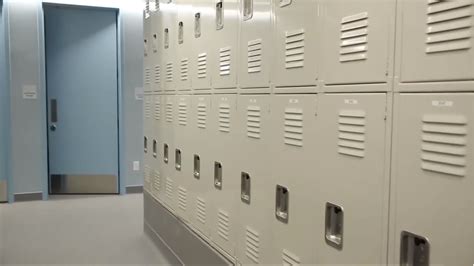Introduction
Coed locker rooms, where individuals of different genders share the same space for changing and showering, have sparked both enthusiasm and controversy. This guide will delve into the advantages and disadvantages of coed locker rooms, exploring their potential benefits and addressing concerns and considerations.

Benefits of Coed Locker Rooms
Inclusivity and Equity
Coed locker rooms eliminate the need for separate facilities based on gender, promoting inclusivity and equity. This can foster a sense of belonging and acceptance among individuals who may not identify with traditional gender roles or who may feel uncomfortable in gender-segregated spaces.
Convenience and Efficiency
Shared locker rooms can save space and resources by eliminating duplicate facilities. This can be particularly beneficial in limited-space environments, such as fitness centers or schools.
Increased Safety
Some studies suggest that coed locker rooms may be safer than single-gender facilities. The presence of individuals of different genders can act as a deterrent to inappropriate behavior and create a more watchful environment.
Reduced Stigma
Coed locker rooms can help reduce the stigma associated with certain body types or gender expressions. By exposing individuals to a wider range of physical appearances, coed spaces can promote body positivity and acceptance.
Considerations and Concerns
Privacy and Comfort
Privacy is a primary concern in coed locker rooms. Individuals may feel uncomfortable or exposed when sharing a changing and showering space with members of the opposite gender. Measures to address privacy concerns include providing individual stalls, showers with curtains, and designated areas for dressing.
Harassment and Misuse
While coed locker rooms may reduce the risk of certain types of harassment, they also raise concerns about potential misuse or inappropriate behavior. Establishing clear rules, supervision, and reporting mechanisms is crucial to prevent such incidents.
Cultural and Religious Factors
Cultural and religious beliefs can influence attitudes towards coed locker rooms. Some individuals may find the concept unacceptable based on their values or traditions. Respecting cultural and religious differences is essential in creating a welcoming and inclusive environment.
How to Implement Coed Locker Rooms
Step-by-Step Approach
- Planning: Assess the need for coed locker rooms, considering the specific circumstances and stakeholder perspectives.
- Consultation: Engage stakeholders, including users, staff, and administrators, in open dialogue to discuss concerns and seek feedback.
- Design: Create a facility that balances privacy, safety, and convenience. Include features such as individual stalls, separate showers, and designated dressing areas.
- Implementation: Introduce coed locker rooms gradually, providing orientation and support to users.
- Evaluation: Monitor the implementation and gather feedback from users to make necessary adjustments and improvements.
Why Coed Locker Rooms Matter
Breaking Down Gender Barriers
Coed locker rooms challenge traditional gender roles and break down barriers of separation. They foster inclusivity and promote respect for individuals regardless of gender identity or expression.
Encouraging Body Positivity
By exposing individuals to a wider range of body types, coed spaces can promote body positivity and help reduce body shame. This can benefit individuals who may feel insecure about their bodies or struggle with body image issues.
Making Spaces More Accessible
Coed locker rooms make fitness and recreation facilities more accessible to individuals who may feel uncomfortable or excluded in gender-segregated spaces. This can increase participation in physical activity and promote well-being.
Pros and Cons of Coed Locker Rooms
Pros:
- Inclusivity and equity
- Convenience and efficiency
- Increased safety
- Reduced stigma
- Promotion of body positivity
Cons:
- Privacy and comfort concerns
- Potential for harassment and misuse
- Cultural and religious objections
New Applications of Coed Design
De-gendering Public Spaces
The concept of coed locker rooms can be extended to other public spaces, such as restrooms, showers, and changing rooms in schools, workplaces, and public facilities. This can create more inclusive and equitable spaces for individuals of all genders.
Flexible and Adaptable Spaces
Multipurpose spaces that can be used for different purposes, including coed locker rooms, can increase space utilization and flexibility. This approach allows facilities to adapt to changing needs and preferences.
Conclusion
Coed locker rooms offer potential benefits in terms of inclusivity, convenience, safety, and body positivity. However, they also raise concerns about privacy, harassment, and cultural acceptance. By carefully considering these factors and implementing thoughtful design and policies, facilities can create coed locker rooms that are safe, welcoming, and beneficial to all users.
Tables
Table 1: Benefits of Coed Locker Rooms
| Benefit | Explanation |
|---|---|
| Inclusivity and Equity | Eliminate gender-based segregation, fostering a sense of belonging and acceptance |
| Convenience and Efficiency | Save space and resources by eliminating duplicate facilities |
| Increased Safety | Presence of individuals of different genders can deter inappropriate behavior |
| Reduced Stigma | Expose individuals to a wider range of body types, promoting body positivity and self-acceptance |
Table 2: Considerations and Concerns of Coed Locker Rooms
| Concern | Explanation |
|---|---|
| Privacy and Comfort | Individuals may feel uncomfortable sharing changing and showering space with members of the opposite gender |
| Harassment and Misuse | Coed locker rooms raise concerns about potential harassment or inappropriate behavior |
| Cultural and Religious Factors | Cultural and religious beliefs can influence attitudes towards coed locker rooms |
Table 3: Step-by-Step Approach to Implementing Coed Locker Rooms
| Step | Description |
|---|---|
| Planning | Assess need, consider stakeholder perspectives |
| Consultation | Engage stakeholders in dialogue, seek feedback |
| Design | Create facility balancing privacy, safety, convenience |
| Implementation | Introduce coed locker rooms gradually, provide orientation and support |
| Evaluation | Monitor implementation, gather feedback, and make adjustments |
Table 4: Pros and Cons of Coed Locker Rooms
| Pros | Cons |
|---|---|
| Inclusivity and equity | Privacy and comfort concerns |
| Convenience and efficiency | Potential for harassment and misuse |
| Increased safety | Cultural and religious objections |
| Reduced stigma | |
| Promotion of body positivity |
